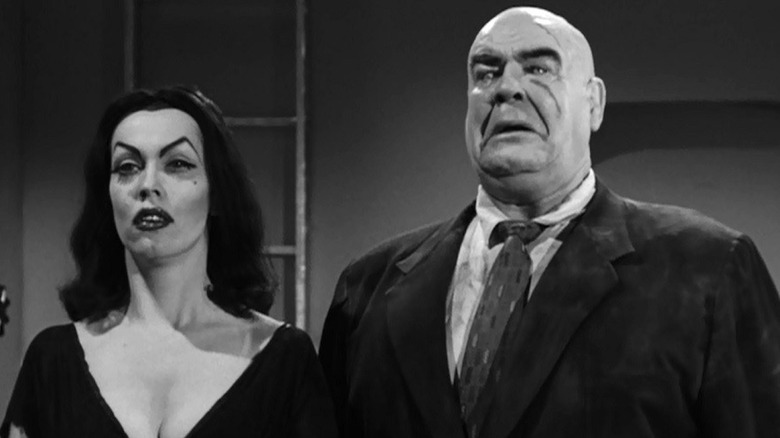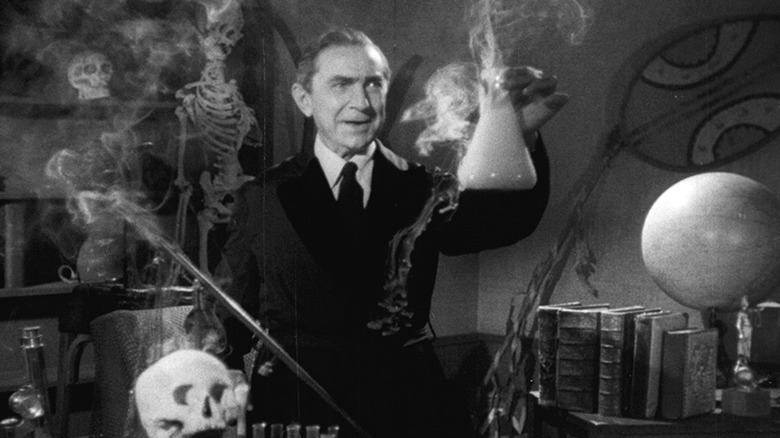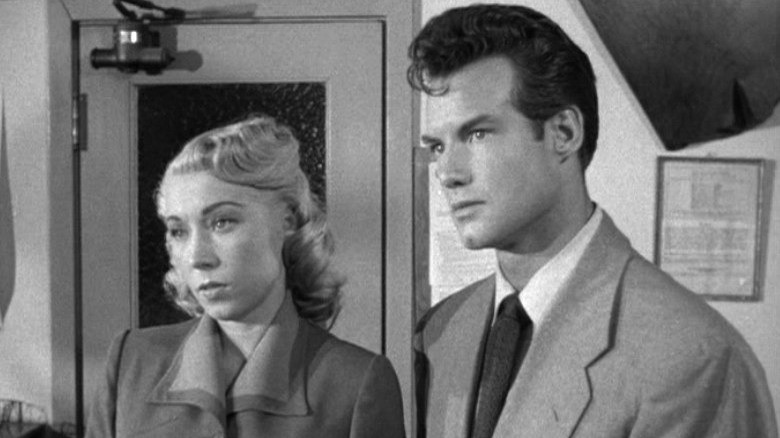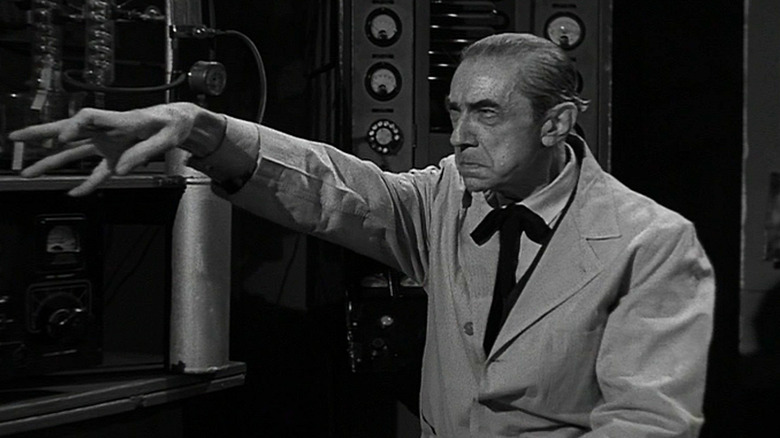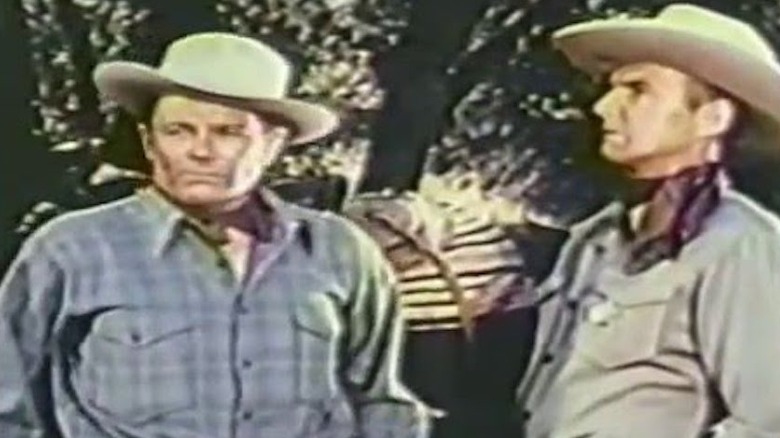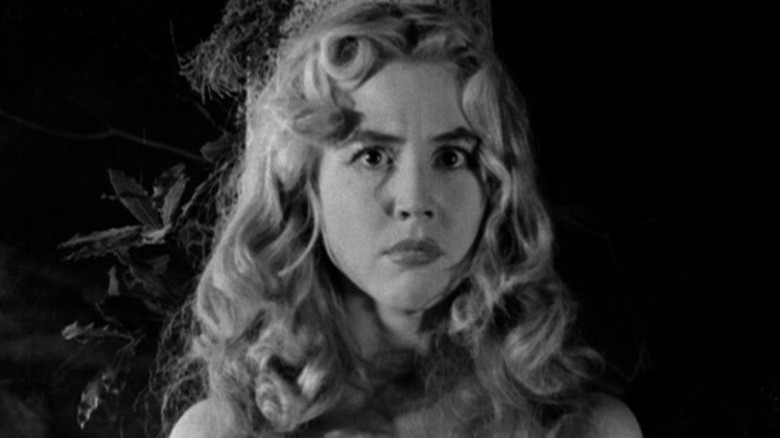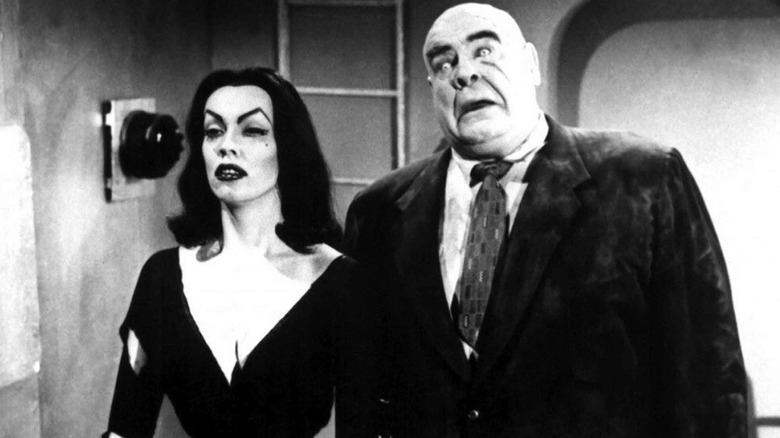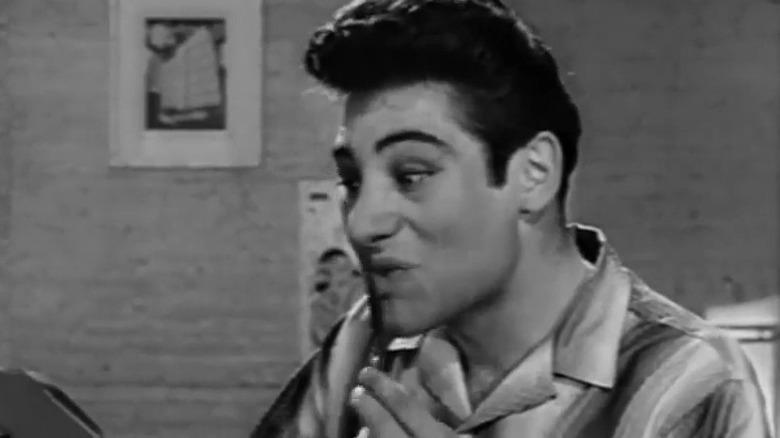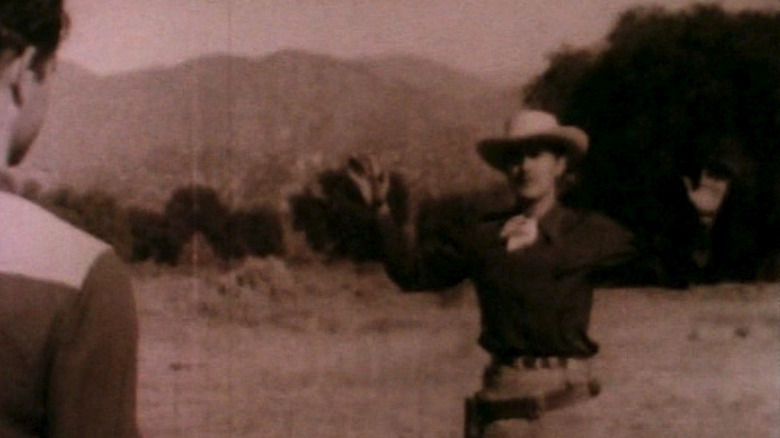Every Ed Wood Movie Ranked Bad To Worst
Purveyor of any kind of film he could make, be it a documentary, a drama, a science fiction adventure, or even an X-rated romp, Ed Wood took his career to all corners. After his service in World War II, he followed his heart, took off to Hollywood, and did whatever he could to make his movie-making dreams come true.
Eventually, he took it upon himself to make movies his own way, and despite a lack of funding, zero studio interest, and little help, Wood managed to cobble together a number of movies in his career. That includes the infamous "Plan 9 from Outer Space," considered by some as one of the worst movies ever made. Hundreds of personal projects went unfinished, and he kept himself afloat as a writer and assistant director on more legitimate work. Late in his career, he dove into adult films — which we won't cover here — and it's not an exaggeration to say that not a single one of even his legitimate movies was ever well-reviewed or a hit at the box office.
Still, thanks to a cult following years after his heyday, where his films became celebrated for their quirky charms and oftentimes subversive subject matter, Wood eventually became a B-movie icon himself and the subject of a big-budget biopic from Tim Burton. Though considered one of the worst directors of all time, Ed Wood is also an LGBTQ+ icon, and there are droves of fans who love him for his offbeat films. So here they are — all of Ed Wood's movies, ranked from bad to worst.
Glen or Glenda
Next to "Plan 9 From Outer Space," eccentric director Ed Wood's most famous film might be "Glen or Glenda," a story with a very clear personal meaning for him. It might also be his best, if you can call any movie in his filmography good at all. The film is centered on a psychiatrist who tells the stories of two different men, each with their own personal struggles that parallel one another.
The first is Glen, a man who privately enjoys wearing women's clothing and longs for the day when such proclivities need not be hidden. As it stands now, however, he lives in fear of telling his fiancee Barbara about what he does when she's not around. The other person is Glenda, born a man, who is about to undergo a gender reassignment operation. Equal parts drama, exploitation, pseudo-documentary, and even horror, it featured former monster movie legend Bela Lugosi, as well as Wood's own girlfriend at the time, Dolores Fuller, who played Barbara opposite to Wood's Glen.
The making of "Glen or Glenda" proved a centerpiece to Tim Burton's biopic, as many elements of the story were very much a translation of the director's own life. Though the acting is awful and the production cheap, it's Wood's connection to the material that likely helped him form this into a better film than others in his catalog. In a very real way, it could be seen as an artist asking for respect for his choice of lifestyle and gender identity, which is one reason it has become a legendary work in some LGTBQ+ circles.
Jail Bait
With a name like "Jail Bait" and schlock auteur Ed Wood at the helm as director, you would not be unreasonable to assume this movie is some kind of sleazy adult entertainment, but in fact, it's actually a sleazy crime drama. In some ways, it's Wood's attempt at something more serious, but perhaps because of that, it's even worse than most, as it lacks the camp that makes some of his other works at least enjoyable in a "so bad it's good" kind of way. Also, some dated racial humor — that may actually be an attempt to lampoon Hollywood itself, but it's hard to tell — makes the film an extremely uncomfortable watch these days, so if you decide you want to give this one a whirl, be warned.
The movie is the story of two violent criminals who rob a movie theater, only to find themselves on the run from police. Eventually, one of the thugs attempts to have his identity changed through radical plastic surgery, which winds up backfiring on him. A clever crime noir, it's got an intriguing premise and some promising twists, but poor performances — par for the course in Ed Wood movies — predictably hold it back, and an overly and unnecessarily complicated script muddle the proceedings.
Ultimately, it's a bad attempt at a crime thriller and mostly notable today for being the first credited film role for bodybuilder-turned-actor Steve Reeves, who went on to star in "Hercules" and "The Thief of Baghdad."
Bride of the Monster
In the 1950s, Ed Wood's friendship with fading Hollywood legend Bela Lugosi helped push him toward horror films. Himself struggling to find work that decade, Lugosi united with Wood for multiple projects, with Wood dreaming up a variety of stories for the former Dracula star. But despite many of the ideas never seeing the light of day, one of the few that did come out of their work together also proved to be one of Wood's least awful films: "Bride of the Monster."
Released in 1955, Ed Wood chronicler Dead 2 Rights notes that the film was mainly funded by a meat packing magnate named Donald McCoy, whose son Tony took the lead role in the film — his only major acting credit. The film also starred Wood regular Tor Johnson as his famous Lobo character alongside Lugosi and Loretta King. The making of the film was a plot point in the Tim Burton classic "Ed Wood."
The film is a rather thinly plotted stereotypical monster movie about a mad scientist (Lugosi) who attempts to bring to life an army of monster men. There's some social allegory about nuclear proliferation tucked in there too, and while it suffers the same problems as many of his other films, its simpler, more straight forward story makes it a bit more comprehensible than some. But it was still horrendous enough that it was the first of three Ed Wood films to be riffed on in "Mystery Science Theater 3000."
Crossroad Avenger: The Adventures of the Tuscan Kid
An attempt to develop a Western for a proposed television series, there's actually two versions of this one, each about a half an hour in length. The other version is called "Boots," but the more commonly known edition is "Crossroad Avenger: The Adventures Of The Tuscan Kid." It starred journeyman TV actor Tom Keene as the titular Tuscan Kid, and was apparently aired as a standalone television "movie" in the early 1950s. The Kid himself was an insurance claims adjustor who would investigate various cases and find trouble along the way. Had it gone to series, no doubt the Tuscan Kid would have found himself in a new town each week, with new adversaries and allies as well.
The movie stars Western TV veteran Tom Tyler — who also made appearances on "The Gene Autry Show" and "Stagecoach," among others — who plays a sheriff's deputy named Ed. In this "film," the Tuscan Kid arrives in a backwater town after a saloon has burned to the ground, and its owner is adamant about a cash payout. But we soon learn there's more to the story as the co-owner died in the fire, which may have been arson intended to kill him.
Also written by Wood, "Crossroad Avenger" isn't a bad story on paper and proves that when the director wanted to, he was capable of crafting a compelling concept. Unfortunately, it's a pretty poorly produced pilot and film that didn't get picked up, and its low budget and stiff acting are bad even for the standards of the day.
Night of the Ghouls
Reuniting with Tor Johnson and much of the same cast as his earlier horror effort "Bride of the Monster," Ed Wood embarked on a new tale of terror in 1959 in what is essentially a sequel to that film. Sadly, star Bela Lugosi had died three years earlier, and Wood made no effort to mimic him with a copycat actor as he did in "Plan 9." Instead, the director casted actor Kenne Duncan (who was mostly known for Westerns) as a new character, "Dr. Acula," a name that every 10-year-old thought was extremely clever in its subtlety.
A full collection of Wood regulars like Tom Mason, Duke Moore, Don Nagel, and Paul Marco round out the cast, and young blonde actress Valda Hansen joined them as an apparition. The plot this time around concerns a psychic medium who — along with his alluring girlfriend — is exposed as a fraud, attempting to con unsuspecting rubes out of their money by claiming he can commune with ghosts.
As usual, though, it's the behind-the-scenes craziness that trumps anything on screen. Refusing to waste an ounce of celluloid and hoping to stretch his nonexistent budget, Wood filled out the film by recycling footage from other failed projects, including from his never completed horror epic "Final Curtain" (via Dead 2 Rights). This leaves "Night of the Ghouls" like many of Ed Wood's most infamous projects: a series of loosely connected bits that barely manages to tell something resembling a coherent story.
Plan 9 from Outer Space
Ironically, the most famous film on Ed Wood's resume, beloved as one of the worst films ever made, is not actually his worst film. But it is up there ... or down there, depending on how you look at it. A confusing mess of a movie, its star Bela Lugosi died during filming, so Wood decided to scrape together every last bit of footage he had of the legendary actor, including various bits and pieces shot for other half-realized projects, and recycle them in the film in the most bewildering ways. Combined with replacement actor Tom Mason — who was noticeably taller than Lugosi — Wood was able to cobble together something that loosely resembled a story. The degree of success he was able to achieve is up to viewers.
The film begins with a race of aliens who have arrived from outer space to warn Earth about their development of a doomsday weapon. When the human race doesn't listen, the aliens enact "Plan 9," which will raise the dead and turn their corpses into ghouls who terrorize the living in an attempt to get people to listen. In addition to Lugosi and his usual cast of actors, Wood also got an appearance from horror host Vampira.
Though mostly a forgotten feature, it found new life in reruns on television in the 1960s before being featured in a book called "The Golden Turkey Awards: Nominees and Winners, the Worst Achievements in Hollywood History," where it was crowned the worst film ever made (via Far Out Magazine). From there, it gained infamy and a cult following, becoming popular as one the greatest "so bad it's good" B-movies of all time.
The Sinister Urge
Featured on "Mystery Science Theater 3000" in 1994, "The Sinister Urge" may be one of Wood's worst, but it may also be one of his most interesting. A crime drama that follows a crooked couple on the run, it puts a twist on the formula and makes the woman the mastermind of their scheme, something nearly unheard of in cinema at the time. Her name is Gloria, and she works for the mafia, producing movies of the lurid, low-budget sleaze kind. Her boyfriend is Johnny Ryde, who directs the pornographic pictures, himself a disgraced filmmaker reduced to selling smut for the mob.
In the film, Gloria and Johnny get into more trouble than they bargain for thanks to Dirk, a mafia thug who is there to kill anyone who might get in the way of their illegal operation. On paper, it sounds like a promising thriller, but in the hands of director Ed Wood — who clearly used his own life as inspiration for the film — it's little more than a junk movie that tries to have a message and fails miserably.
The film is a hard-boiled crime noir drama in concept that offers no suspense, a contrived story, flat and boring characters, and of course, the embarrassing shoestring budget fans have become used to in Ed Wood films. The biggest problem it faces, however, is that it has none of the usual oddball and eccentric charm Wood was able to infuse — by accident or otherwise — in movies like "Plan 9," "Bride of the Monster," or even "Jailbait."
Streets of Laredo
One of the earliest — possibly the first — attempts at filmmaking by director and screenwriter Ed Wood, "The Streets of Laredo" was a Western inspired by Wood's love of the genre during his youth. He wrote, produced, directed, and even starred in this minimalist, almost avant-garde Wild West adventure, which was only completed after his death. Incomplete in his lifetime, it was finally finished in the mid-1990s after Tim Burton's biopic brought the B-movie icon renewed attention from the public.
The final product is called "Crossroads of Laredo" and is mostly a silent film complimented by classic Western music. The film's dialog is sparse, with the action attempting to tell the story. Though an extremely short film, like many of Wood's works, it remains a slog despite its short runtime, as the production is so primitive that you might think it was made 50 years before. Whether this is by design or just a quirk of Wood's low-budget nature is anyone's guess. A narration added in the '90s helps smooth over the story, which otherwise might not make any sense at all.
Story-wise, the movie centers on two men, both vying for the affection of the same woman. Tex is married to poor Barbara and has fathered a child with her but spends all of his time drinking and carousing with other women. Lem is a gunslinger who, by contrast, adores Barbara more genuinely and resents how Tex has been treating her. It's barely a story and, frankly, barely a movie. But that's Ed Wood for you.
